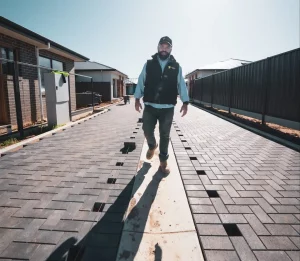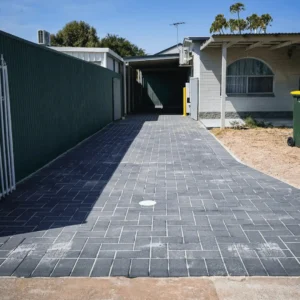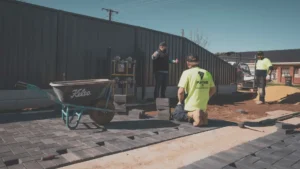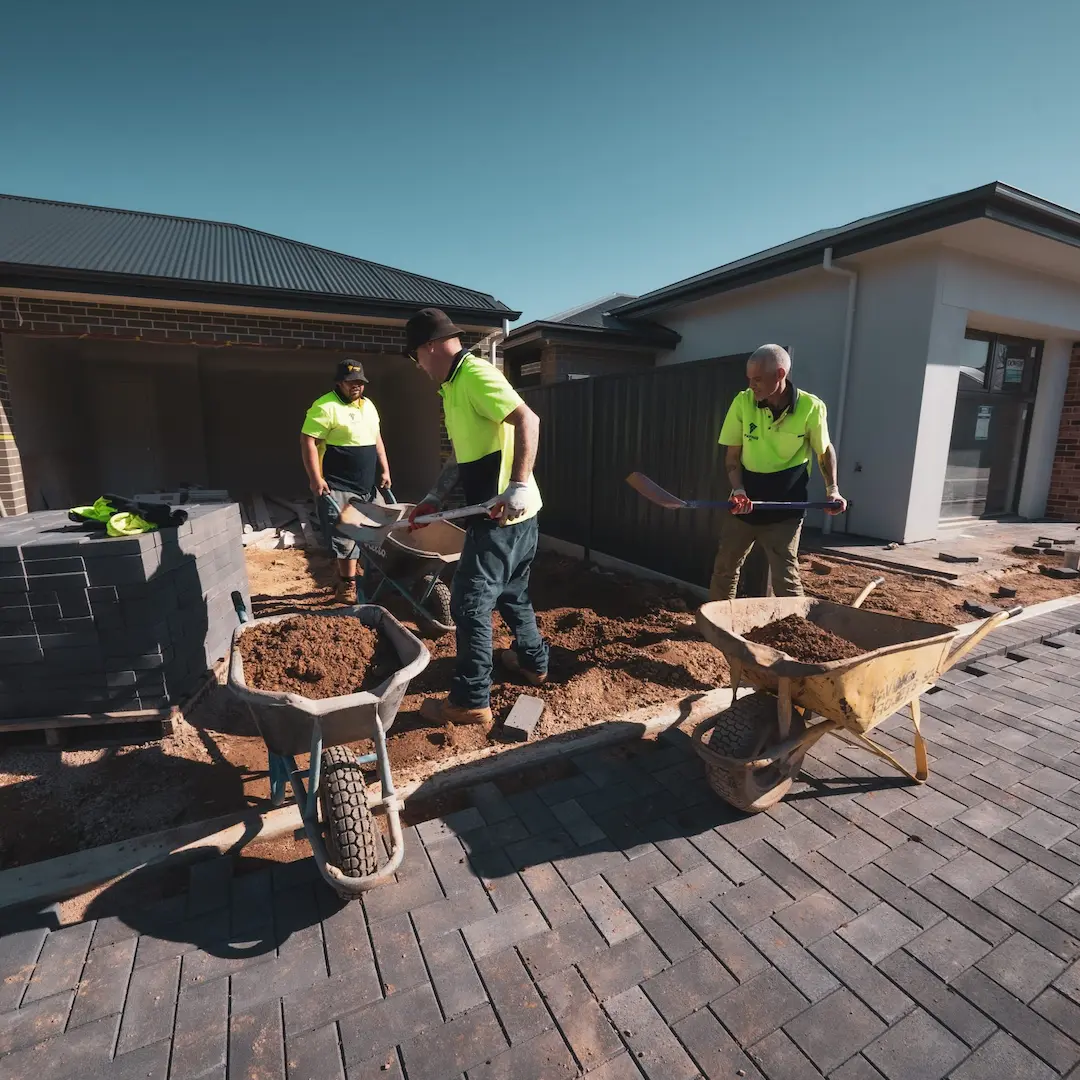Are you investing in pavers and curious to know how long pavers last? Typically, quality pavers have a lifespan ranging from 25 to 100 years, influenced by factors like material, installation, and care. In the following sections, we’ll explore the essentials of paver durability, what impacts their longevity, and tips to maximise their lifespan, so your investment stands solid year after year.
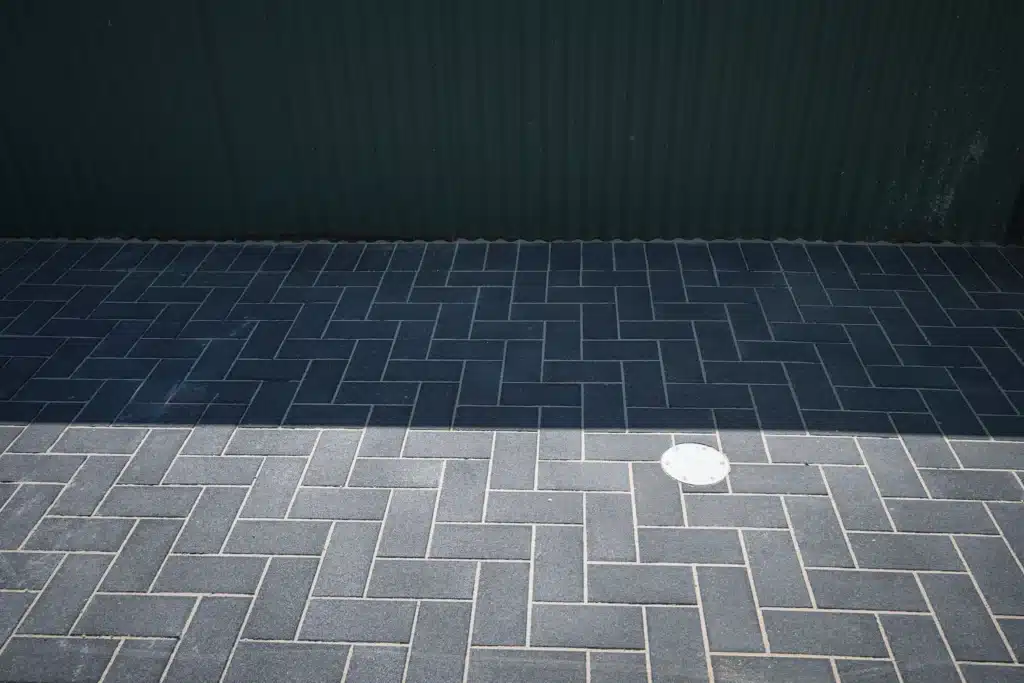
Key Takeaways
- Pavers can last 50 to 100 years with proper installation and regular maintenance, with brick pavers generally outlasting concrete pavers.
- Correct installation—including a stable base and efficient drainage—is key to paver longevity, and regular maintenance like sealing and cleaning extends paver life.
- Mistakes in paver installation, such as improper base depth, inadequate drainage, or incorrect edging, can lead to shifting, settling, and reduced lifespan of pavers.
Paver Longevity: Understanding the Basics
Imagine a stunning paver patio or stone walkways gracing your outdoor space, with the potential to last from 50 years to over a century! It’s true—properly installed and maintained pavers can endure an extensive period of time. The remarkable durability of these hardscaping elements is due to various factors synergistically contributing to their longevity.
The average lifespan of brick pavers, which typically exceeds 25 years, along with that of other paving stones, depends largely on three critical aspects: the calibre of materials utilised in them, how accurately they are laid during the installation process, and commitment to ongoing maintenance efforts. Beyond just lasting for decades with proper care, there is another benefit. Individual pavers’ design allows replacing single pieces as necessary rather than entire sections thereby presenting long-term savings despite initial costs associated with purchasing and laying them down.
Material Matters: Brick vs. Concrete Pavers
Brick and concrete are two prominent materials used for pavers, with brick often outshining concrete in longevity. When maintained correctly, brick pavers can remain intact from half a century to an entire century. In contrast, the lifespan of concrete pavers is around 25 years. This demonstrates that when it comes to endurance over time, brick proves superior.
Though designed with a service life close to 25 years, concrete pavers don’t fare as well against environmental stressors such as temperature changes and heavy loads, particularly on a poured-concrete patio where they’re more prone to crack compared to bricks.
For those embarking on installing paving stone walkways or constructing a stylish paver patio using paving stones, the choice between these materials will significantly influence your outdoor space’s overall durability and maintenance requirements for both patios and walkways alike.
The Role of Installation in Paver Durability
The longevity and durability of pavers are heavily dependent on the correct installation process. A robust foundation, using materials such as crushed stone or concrete, is essential to provide a stable and level base which significantly contributes to the durability of the pavers. Proper drainage is key—achieved through suitable base materials—to avoid water accumulation that could cause damage to the pavers, thus extending their lifespan.
For a resilient paver setup it should include:
- A solidly compacted gravel or crushed rock layer
- Bedding sand for levelling
- The placement of the brick pavers themselves
- Joint sand employed to secure them in place
The interlocking design characteristic of these types of paving stones plays an integral role by accommodating movement and preventing stress cracks caused by changes in temperature. When executed with expertise employing quality techniques and resources—the lastingness of your brick pave way can be considerably enhanced.
Factors That Influence Paver Lifespan
Numerous factors beyond material selection and installation methods impact the durability of paver installations. Extreme weather conditions, such as intense heat or cold, along with shifts in climate patterns, can contribute to the wear and tear of paving stones. Specifically, travertine pavers may show accelerated signs of ageing due to their inherent textural properties, mineral content, and level of porosity.
The stability and composition of the ground beneath where pavers are laid also plays a critical role in determining how long they will last. The type of soil affects pavement longevity. Soils that expand during frost events can lead to damage while ensuring adequate drainage helps mitigate erosion-related issues and keeps standing water from weakening the integrity of paved areas.
Regular maintenance efforts serve to extend the life expectancy of paved surfaces further. Protective measures like sealing help guard against environmental degradation while addressing regular use impacts—such as heavy traffic—all contribute positively towards preserving pavement condition over time.
Weather Woes: Temperature Changes and Pavers
Drastic fluctuations in temperature can lead to the expansion and contraction of the ground, causing pavers within patios or walkways to become misaligned over time. Imagine your neatly installed paving stone walkways or paver patio gradually transforming into a disorganised puzzle with pieces that no longer fit snugly together—it’s hardly an appealing scenario.
There is a reliable solution for this issue. During the installation process of stone walkways and patios, professionals often advise using polymeric sand. This ensures that each individual paver is set correctly, averting separation due to thermal changes. Polymeric sand creates a durable yet flexible barrier keeping everything securely intact so that whether it’s pouring rain, beaming sunshine or snowy days, the integrity of your meticulously laid out pathways and patios remains impeccable and visually pleasing.
Maintenance Musts: Enhancing Paver Life
To maintain the aesthetics and durability of pavers, consistent upkeep is essential. Applying a high-grade sealant to the pavers can shield them from degradation from exposure to elements such as grime, mould, dirt, weather conditions and prevent stains—all while improving their visual appeal.
To sealing, proper care for your pavers includes:
- Regular removal of efflorescence via brushing
- Using soapy water or particular cleaning solutions tailored for specific stain types like tannins or oil
- Direct application of herbicide on spots to inhibit weed proliferation
- Disinfecting areas prone to fungal growth
Adopt these measures into your regular maintenance routine for keeping pavers clean.
By performing weekly sweeps and washes with either a simple garden hose or employing a power washer for more stubborn deposits ensures that you keep your paving stones in top-notch condition over time.
Common Missteps in Paver Installation
The process of installing pavers requires precision and attention to detail. Mistakes during installation can result in the shifting of pavers, their settling into the ground, or premature deterioration. One common mistake involves setting an inadequate base depth or failing to compact the substrate properly. It is essential that the base layer be sufficiently deep—typically between 4 to 6 inches—and possibly up to 9 inches for areas with higher anticipated weight loads, so as to assure enduring stability.
Another typical challenge arises from substandard drainage and incorrect sloping due oftentimes to deficient installation practices. When pavers lack adequate draining capacity and are not angled correctly for water run-off, they may shift position, sink downwards or even damage adjacent structures owing to accumulated moisture. Using inappropriate backfill material such as dirt instead of gravel—or neglecting a well-graded slope—are frequent contributors to major shifts in paving alignments because of improper installations.
Correct edging plays a pivotal role in preventing paver displacement. Exceeding one inch when applying bedding sand could cause wobbling or sinking issues among installed units. Significant is selecting appropriate types of pavers tailored specifically for the project at hand and its local climate conditions—inapt choices here might curtail product lifespan notably since these typically fall outside warranty protections against faults arising out this sort of mismatch.
Avoiding Uneven Surfaces: The Importance of Proper Laying
The success of a paver installation relies heavily on precision and the correct application of techniques to ensure stability and levelness. A 1-inch thick sand layer is recommended for proper support during paver installation, helping avoid any potential uneven surface issues. The screeding technique is used to create an even bedding sand surface that serves as a base for laying the pavers, which is vital in securing an even and stable finished product.
It’s important to meticulously smooth out the sand before placing each paver in order to eliminate any bumps or imperfections. Employing the click-and-drop method when installing pavers not only maintains a level field, but also preserves the integrity of your carefully prepared sand bed, preventing it from becoming disrupted—which can result in an unsatisfactory finish. An uneven surface doesn’t just detract from visual appeal. It may pose safety risks and diminishes the longevity of your installed pavers.
Enhancing Outdoor Space with Durable Pavers
Choosing pavers for enhancing your outdoor area is beneficial primarily because they offer superior durability over standard options such as concrete slabs and stamped concrete, thus ensuring a longer-lasting pavement solution. The versatility in design that pavers provide allows the creation of distinctive patterns such as herringbone or circular layouts that can be tailored to match the aesthetic of your home’s architecture.
When compared to conventional concrete solutions, pavers contribute positively to the environment by minimising water runoff and mitigating urban heat island effects. Not only do these benefits consider environmental impacts, but also add value to properties due to their upscale appeal characterised by their beauty, slip-resistant features, and robustness. Opting for pavers essentially means giving your outdoor space an upgrade in both allure and resilience.
Aesthetic and Functional Benefits
Pavers come with an extensive selection of hues, patterns, and textures that enhance design flexibility, enabling the creation of more unique and imaginative outdoor living spaces. They cater to various style preferences from achieving a traditional rustic allure to embodying contemporary sophistication. Pavers are key in realising your vision for aesthetic perfection.
Pavers excel not just in their visual attributes, but also in practicality. They outperform alternative materials by offering enhanced slip resistance, which is crucial for maintaining safety on surfaces such as driveways and patios. Those residing in warmer regions will find pavers beneficial due to their ability to maintain cooler surface temperatures than concrete—this feature is especially advantageous around pool areas where comfort underfoot is paramount.
Cost Considerations: Upfront Cost vs. Long-Term Value
Despite the initial investment for concrete pavers being higher than that of concrete slabs, their durability and lower maintenance needs make them a more cost-effective choice over time. When properly installed and cared for, these pavers can surpass most poured concrete surfaces in longevity. Although you may spend more upfront, the enduring value provided by pavers should not be underestimated.
Pavers add to a property’s marketability through both their visual charm and robustness—qualities that prospective homebuyers find appealing. They offer ease of upkeep and when repairs are necessary, typically only the affected pieces need replacement. This feature not only maintains their attractive appearance, but also enhances overall cost savings in terms of long-term maintenance.
Preserving Your Investment: Paver Care Tips
While pavers are a sturdy and durable choice for your outdoor space, they necessitate some care to maintain their beauty and longevity. One effective way to do this is by using dried sand or polymeric sand, such as Pave Set, to fill the joints between pavers. This not only inhibits weed growth but also helps keep the pavers in place.
During the settling period, use a stiff outdoor broom or a leaf blower at an angle for sweeping. This process helps protect the joint sand while ensuring the stability of the pavers. Regular sweeping and the occasional washing of pavers are necessary to maintain their appearance and prevent the accumulation of stains.
For tougher cleaning tasks, like removing dried mortar stains, use a specific acid-to-water mixture to get pavers squeaky clean without causing damage.
Sealing for Longevity: Is It Necessary?
It is absolutely essential to seal pavers, as many homeowners are curious to know. Sealing not only helps prevent the pavers from shifting and keeps the surface level, but also prolongs their service life significantly. A helpful piece of advice: sealing your pavers once every two years is a good practice. For those with new installations, apply a high-quality sealer promptly. This can be beneficial for paver surfaces that are up to a decade old.
There’s an array of sealer options available tailored to meet various preferences, whether you’re looking for something that enhances the aesthetics or maintains a more natural appearance of your pavement—each intended for specific uses. Some manufacturers provide warranties that could potentially last forever if you stick strictly to regular maintenance routines which include periodic sealing — effectively offering what amounts to a lifetime guarantee on your paving stones.
Paver Warranties and Guarantees
Pavers come with substantial warranties, much like other high-quality products do. These lifetime guarantees safeguard against flaws in materials and craftsmanship, signalling the producer’s trust in their paver’s resilience. In terms of structural integrity, such as that pertaining to the foundation on which the pavers are laid, these components are Covered for a minimum period of six and a half years against any structural deficiencies. At Paving SA, we offer a lifetime workmanship guarantee on all our paving projects. We build to last. All our work is backed by our lifetime guarantee. Checkout our range of paving services for more information! For the beset paving adelaide has to offer, speak to our friendly team to organise a free quote!
It is important to note that conditions including efflorescence – deposits left from water evaporation – normal deterioration due to use or exposure to elements over time (weathering) and reactions like oxidation aren’t usually included under warranty coverage since they’re expected results rather than indications of faulty manufacturing. Improper handling or usage leading up to excessive weight bearing on them can nullify said warranty. This also includes damage resulting from harsh chemicals or incorrect application of de-icing solutions.
Summary
The durability and visual appeal of pavers make them an excellent option for enhancing outdoor areas. The lifespan of these pavers is influenced by critical factors such as material quality, proper installation, and consistent maintenance. When properly cared for, they can significantly beautify your outdoor space for a century—now that’s a testament to their robustness and worthiness as an investment!
Frequently Asked Questions
What lasts longer concrete or pavers?
Pavers made of concrete are typically more durable than poured concrete, potentially enduring for upwards of 30 years with little maintenance needed.
Are pavers high maintenance?
Contrary to what some might believe, pavers do not require a lot of upkeep. Simply sweeping them regularly and applying sealant occasionally can safeguard them, thus simplifying their maintenance.
When it comes to repairs, they offer a much more straightforward solution than concrete patios do. Repairs on paver installations are seamlessly accomplished with relative ease.
What is the lifespan of a brick paver?
The durability of brick pavers ranges from 25 to 100 years, and certain natural stone pavers can even surpass a century if they are installed correctly. Ensuring proper installation is key to extending their lifespan.
What factors influence the lifespan of pavers?
Factors including the calibre of materials used, methods employed during installation, prevailing weather conditions, composition of the underlying substrate and consistent maintenance are critical determinants in establishing how long pavers will last. These elements significantly impact the durability of pavers.
How often should pavers be sealed?
It is essential to apply a high-quality sealer to new paver installations promptly.
To preserve the structure and aesthetic of your pavers, ensure they are sealed once every two years at a minimum.

